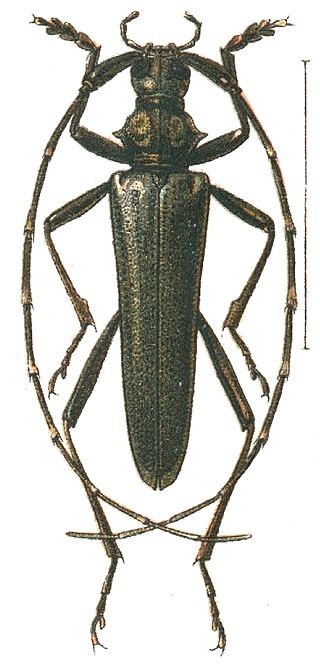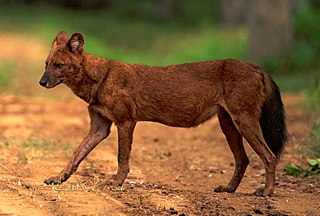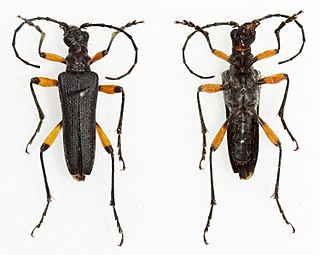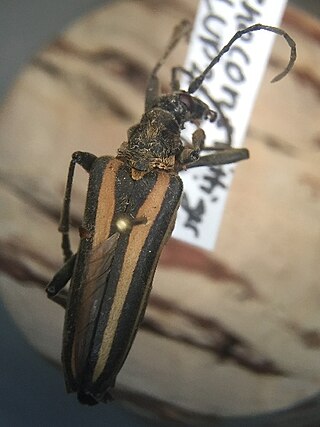
The International Union for Conservation of Nature (IUCN) Red List of Threatened Species, also known as the IUCN Red List or Red Data Book, founded in 1964, is an inventory of the global conservation status and extinction risk of biological species. A series of Regional Red Lists, which assess the risk of extinction to species within a political management unit, are also produced by countries and organizations.

The Disteniidae are a small family of beetles in the superfamily Chrysomeloidea, traditionally treated as a group within the Cerambycidae.

Lepturinae, the lepturine beetles, is a subfamily of the longhorn beetle family (Cerambycidae), containing about 150 genera worldwide. This lineage is most diverse in the Northern Hemisphere. Until recently the subfamily Necydalinae was included within the lepturines, but this has been recently recognized as a separate subfamily. Nine tribes are usually recognized today, with a tenth, Caraphiini, created in 2016. A few genera are of uncertain placement within the subfamily.

An endangered species is a species that is very likely to become extinct in the near future, either worldwide or in a particular political jurisdiction. Endangered species may be at risk due to factors such as habitat loss, poaching, invasive species, and climate change. The International Union for Conservation of Nature (IUCN) Red List lists the global conservation status of many species, and various other agencies assess the status of species within particular areas. Many nations have laws that protect conservation-reliant species which, for example, forbid hunting, restrict land development, or create protected areas. Some endangered species are the target of extensive conservation efforts such as captive breeding and habitat restoration.

A species is often defined as the largest group of organisms in which any two individuals of the appropriate sexes or mating types can produce fertile offspring, typically by sexual reproduction. It is the basic unit of classification and a taxonomic rank of an organism, as well as a unit of biodiversity. Other ways of defining species include their karyotype, DNA sequence, morphology, behaviour, or ecological niche. In addition, paleontologists use the concept of the chronospecies since fossil reproduction cannot be examined. The most recent rigorous estimate for the total number of species of eukaryotes is between 8 and 8.7 million. About 14% of these had been described by 2011. All species are given a two-part name, a "binomial". The first part of a binomial is the genus to which the species belongs. The second part is called the specific name or the specific epithet. For example, Boa constrictor is one of the species of the genus Boa, with constrictor being the species' epithet.
BugGuide is a website and online community of naturalists, both amateur and professional, who share observations of arthropods such as insects, spiders, and other related creatures. The website consists of informational guide pages and many thousands of photographs of arthropods from the United States and Canada which are used for identification and research. The non-commercial site is hosted by the Iowa State University Department of Entomology. BugGuide was conceived by photographer Troy Bartlett in 2003 and since 2006 has been maintained by John VanDyk, an adjunct assistant professor of entomology and a senior systems analyst at Iowa State University. The website has been recognized for helping change the public perception of insects.

Stenocorus is a genus of beetles in the family Cerambycidae, containing the following species:
Stenocorus nubifer is a species of beetle from the family Cerambycidae. The species are either black or brown coloured.
Stenocorus cylindricollis is a species of beetle from family Cerambycidae. The species are either black or brown coloured.

Stenocorus schaumii is a species of beetle of the family Cerambycidae that is 17–29 millimetres (0.67–1.14 in) long. The colour is either black or brownish-red. Like other members of the genus, it has wide shoulders and tuberculated sides of the pronotum, with wrinkled elytron. Their larvae feed on Fraxinus, maple, and other hardwood plants.

Stenocorus vittiger is a species of beetle in the family Cerambycidae. Similar to Analeptura lineola, this species has a brown coloured pronotum with 4 black stripes.

Eburia tetrastalacta is a species of beetle in the family Cerambycidae.
Stenocorus alteni is a species of beetle in the family Cerambycidae. It was described by Giesbert and Hovore in 1998.
Stenocorus flavolineatus is a species of beetle in the family Cerambycidae. It was described by John Lawrence LeConte in 1854.
Stenocorus obtusus is a species of beetle in the family Cerambycidae. It was described by John Lawrence LeConte in 1873.
Stenocorus testaceus is a species of beetle in the family Cerambycidae. It was described by Linsley and Chemsak in 1972. It was one of the later discovered species within the Genus Stenocoros, which contains 12 other known species, many of which were discovered in the 19th century.
Stenocorus trivittatus is a species of beetle in the family Cerambycidae. It was described by Say in 1824.

Talsi rolling hills is a nature park in the middle of Talsi Municipality. It is located in the north-western part of Vanemas pauguraine and includes the highest part, administratively belongs to Laidzes, Laucienes and Lībagu parishes. The protected area was established in 1987 to protect one of the North Kurzeme Uplands and highest part of the Elder Hill. It is most diverse areas in terms of natural conditions in the Latvia north-east, with a distinctly hilly terrain and several small but deep lakes. Scenic area. Natura 2000 territory. Many Latvia rare and protected plant and animal species. In total 24 species of flora (1) and fauna (23) are protected under EU Nature directives.









